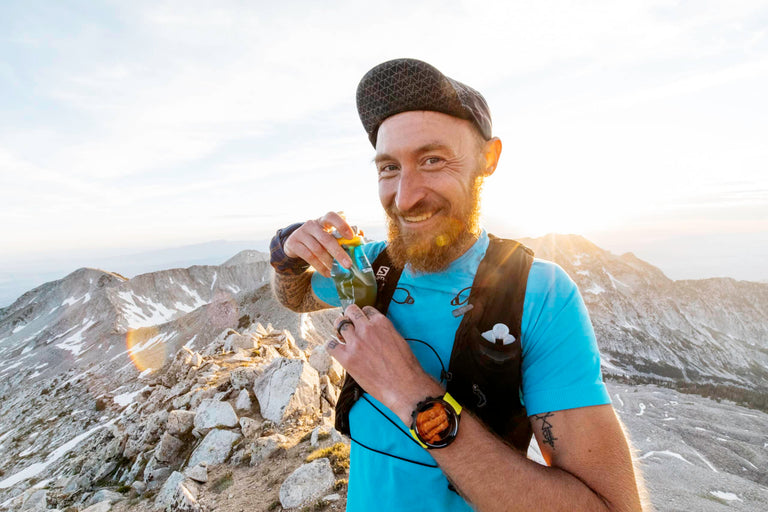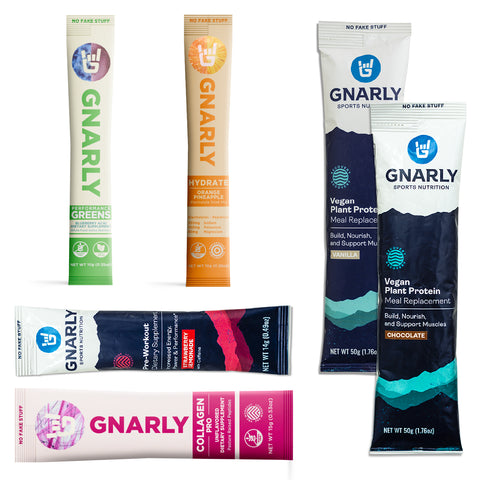Whether you’ve raced double digits worth of ultras or are training for your first, nailing your race-day nutrition could be the difference between a DNF (Did Not Finish) and crossing the finish line, or missing an FKT (Fastest Known Time).
One study even associated greater energy and fluid intake with successful completion of an ultra.(1) Finishers tend to eat more carbohydrates, fat, protein, and overall more total calories than non-finishers. Translation? Your race day fueling plan should garner as much attention as your run training plan.
Professional trail runner and mountain athlete Kelly Halpin agrees, “It’s incredibly important to have a fuel plan for racing or long endurance events. I have definitely had my fair share of bonking, dehydration and nausea during endurance events.”
Below are five key components to consider while you prep for intra-race fueling.
1. Calories
A race’s duration can guide you toward intake goals. A key difference in ultra-endurance running events and shorter running events, is that ultra-racers tend to have lower average work rates given the long duration of the event, which means faster rates of gastric emptying, and therefore a greater tolerance to total calories and calorie dense foods that contain carbohydrates, protein and fat.(3)
While a mixture of carbohydrates, fat and protein can be consumed, carbohydrates should be prioritized. Despite carbohydrate oxidation rates typically being lower during ultra-endurance activity in favor of fat, reduced rate of carbohydrate oxidation coincides or is associated with reduced running speed, glycogen depletion and low plasma sugar, which are associated with cognitive decline. So, if you want to maintain performance and a sharp mind, you must prioritize carbohydrates. If exercise intensity is high, it’s especially important to focus on carbohydrates to sustain work rates.(2) Keep in mind, if you’re new to ultras, it’s best practice to build up tolerance to higher volumes of food, fluid and calories.
For races up to 50 miles, 150-300 kcal/hour is recommended.(4,5,)
For races greater than 50 miles: 200-400 kcal/hour is recommended.(4,5)
Carbohydrates
Calories should be consumed predominantly from carbohydrates: 30-90 g carb/hr.(4,5,) (For reference: 1 gram of carbohydrate equals 4 calories). Obtaining your energy from a combination of liquids, like Fuel20, sports specific foods like gels/chews and regular foods ensures you consume a variety of carbohydrate types, which leads to better digestion and absorption.
Fat
While carbs should be prioritized, two studies associate higher fat intake during ultras with race completion.(3,6) It may be because fat is more calorically dense than carbs (1 gram of fat equals 9 calories) and therefore easier to consume more food, and/or because the higher fat foods consumed are also high in sodium.(1) There are no set fat consumption recommendations for ultra events, so incorporation of fat should be based on individual tolerance, food preference and overall race intensity.
Protein
There’s little research investigating the benefits of protein intake during endurance events. However, given the long duration of these events, it’s likely that protein intake can help reduce the rate of muscle breakdown, and there is even a theory that ingesting Branched Chain Amino Acids (BCAAs) during exercise may reduce fatigue by its connection to serotonin and dopamine receptors!(7,8) Gnarly’s Fuel2O actually contains a metabolite of leucine (a BCAA) called HMB, which delivers 400mg per serving that may be helpful in reducing muscle breakdown during endurance events.(12)
There is no consensus on protein recommendations during ultra events, and one position stand article recommends aiming for 20-30 grams of protein per every 3 hours during an ultra.(1)
Many ultra-runners note that sweet foods become less palatable in the later stages of an ultra and tend to crave saltier, fattier foods.
Big NoNos: Avoid fruit juices and fruits high in sorbitol such as apple juice, prune juice, prunes, and pitted fruits like peaches and apricots. Sorbitol actually pulls water into the digestive tract and can cause diarrhea. Sour candies, rich in citric acid, can irritate the GI tract in large quantities. The lactose in milk can also cause GI distress with physical activity, especially in sensitive folks.
2. Hydration/Electrolytes
Hydration is crucial for hitting your goals, finishing your race and to ensure safety. Dehydration reduces heart rate and cardiac output, which reduces exercise capacity. It can also increase the risk of heat illness and rhabdomyolysis (muscle breakdown that over-works the kidneys).
A hydration plan, like a nutrition plan, should be completely individualized. The best way to assess your hydration needs is determining your own sweat rate by weighing yourself immediately before and after exercise at similar exercise intensity and environmental conditions as race day. Every pound lost during activity is the equivalent to 16 ounces (0.47 L) of fluid. Divide liters by hours to find your hourly sweat rate. It’s recommended to keep weight loss during activity to no more than 2%.
Sodium is another crucial component of fluid balance and muscle contraction. Consuming too little sodium can contribute to hyponatremia, sometimes referred to as over hydration, which is dangerous. Sodium concentration of sweat ranges from 418 – 1628 mg/L, and varies between individuals.(10)
Salty sweaters (those who are often caked in salt on their skin/clothes after a workout) are on the higher end of the range. To help off-set losses, aim for higher sodium fluids that ensure sodium concentrations of 500-700 mg/L of fluid. Salty foods should also be consumed. For reference, 1 tsp of salt is equivalent to 2300 mg of sodium. Other electrolytes such as potassium, magnesium, and calcium are lost through sweat in smaller amounts, although in ultra-endurance events, electrolyte loss besides sodium can become significant given the extended time frame of activity. Opt for a sports beverage that prioritizes sodium and other electrolytes, like Gnarly Hydrate
3. Timing
It’s best to trickle in hydration and foods in more frequent, smaller volumes. So, begin hydrating and fueling early and often in the race. Aim to drink every 5 – 15 minutes depending on sweat rate, and aim to hit your hourly energy goals so you don’t get behind.
Big No-No: Chugging a can of soda at an aid station may sound super appealing, but flooding your GI tract with a ton of sugary beverage at once is a recipe for diarrhea.
4. Food Tolerance
Stomach sloshing, cramping, diarrhea, nausea – most runners have experienced one or all of these nutrition related symptoms. Appropriate hydration, food intake and timing can help mitigate these issues, as well as habituation of high carbohydrate intake during training and getting to the start line well with a trained gut.
Most people who have competed in ultras have experienced nausea related to hypoglycemia (low blood sugar) during a race. The worst thing you can do in that situation is to stop eating and drinking.
Athletes with particularly sensitive stomachs and Irritable Bowel Syndrome (IBS) who struggle with exercise-associated GI-distress despite best efforts to mitigate should consult a sports dietitian/nutritionist.
5. Practice, practice, practice!!
It’s important to practice mid-run fueling to establish tolerance and food preferences, and to get used to eating frequent volumes of fluid and food during training. Aid stations during most ultras provide food and beverages. If you plan to eat the provided foods, find out what’s served and integrate it with your fueling plan during training.
Other Considerations:
The use of Non-Steroidal Anti-Inflammatory Drugs (NSAIDs) like ibuprofen and naproxen is common during races. However, they are also associated with GI distress. Given that NSAIDs are metabolized through the kidneys, there is also potential danger in taking these given increased kidney overload during races. It is strongly discouraged to use these drugs during races given the risks outweigh the rewards, despite the popularity of their intra-race use.(11)
Ultra Marathon Food Ideas:
Baby Food Pouches; Dinner Roll Sandwiches (Ham, a little cream cheese, and jam, or cream cheese, kimchi, & crumbled bacon for examples. Go easy on the filling.); Energy Balls (check out the Gnarly Nutrition recipe!); Gummy Candies; Mashed Potatoes with Parmesan & Salt (can store in reusable food pouches); Onigiri (rice ball with seaweed); PB&J; Potato Chips; Pretzels; Sports Chews; Sports Gels; Sticky Rice Cakes (sweet/savory); Trail Mix, Salted; Quesadillas (with minimal cheese); Waffles
Ultra Marathon Beverage Ideas:
Water; Gnarly Nutrition Fuel2O; Gnarly Hydrate; Coffee (aid station); Tea (aid station)
Citations
- Stuempfle KJ, Hoffman MD, Weschler LB, Rogers IR, Hew-Butler T. Race diet of finishers and non-finishers in a 100 mile (161 km) mountain footrace. J Am Coll Nutr. 2011 Dec;30(6):529-35. doi: 10.1080/07315724.2011.10719999. PMID: 22331688.
- Skeletal muscle adaptation and performance responses to once a day versus twice every second day endurance training regimens. Wee Kian Yeo, Carl D. Paton, Andrew P. Garnham, Louise M. Burke, Andrew L. Carey, and John A. Hawley. Journal of Applied Physiology 2008 105:5, 1462-1470
- Tiller, N.B., Roberts, J.D., Beasley, L. et al. International Society of Sports Nutrition Position Stand: nutritional considerations for single-stage ultra-marathon training and racing. J Int Soc Sports Nutr 16, 50 (2019). https://doi.org/10.1186/s12970-019-0312-9
- Jeukendrup, Asker. “A step towards personalized sports nutrition: carbohydrate intake during exercise.” Sports medicine (Auckland, N.Z.) vol. 44 Suppl 1,Suppl 1 (2014): S25-33. doi:10.1007/s40279-014-0148-z
- Exogenous carbohydrate oxidation during ultraendurance exercise. Asker E. Jeukendrup, Luke Moseley, Gareth I. Mainwaring, Spencer Samuels, Samuel Perry, and Christopher H. Mann. Journal of Applied Physiology 2006 100:4, 1134-1141
- Martinez S, Aguilo A, Rodas L, Lozano L, Moreno C, Tauler P. Energy, macronutrient and water intake during a mountain ultramarathon event: The influence of distance. J Sports Sci. 2018 Feb;36(3):333-339. doi: 10.1080/02640414.2017.1306092. Epub 2017 Mar 21. PMID: 28322630.
- Meeusen, R., Watson, P., Hasegawa, H. et al. Central Fatigue. Sports Med 36, 881–909 (2006). https://doi.org/10.2165/00007256-200636100-00006
- Koba T, Hamada K, Sakurai M, Matsumoto K, Hayase H, Imaizumi K, Tsujimoto H, Mitsuzono R. Branched-chain amino acids supplementation attenuates the accumulation of blood lactate dehydrogenase during distance running. J Sports Med Phys Fitness. 2007 Sep;47(3):316-22. PMID: 17641599.
- American College of Sports Medicine, Sawka MN, Burke LM, et al. American College of Sports Medicine position stand. Exercise and fluid replacement. Med Sci Sports Exerc. 2007 FEb;39(2):377-90.
- Shirreffs SM, Maughan RJ. Whole Body sweat collectionin humans: an improved method with preliminary data on electrolyte content. J Appl Physiol. 1997;82(1):336-341.
11. Guy JH, Vincent GE. Nutrition and Supplementation Considerations to Limit Endotoxemia When Exercising in the Heat. Sports (Basel). 2018;6:1. https://doi.org/10.3390/sports6010012.






